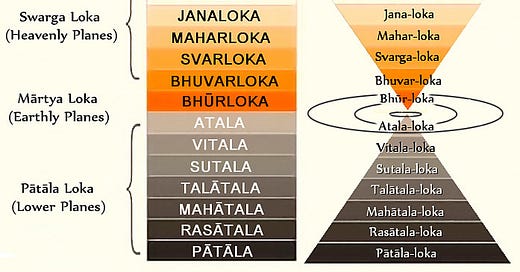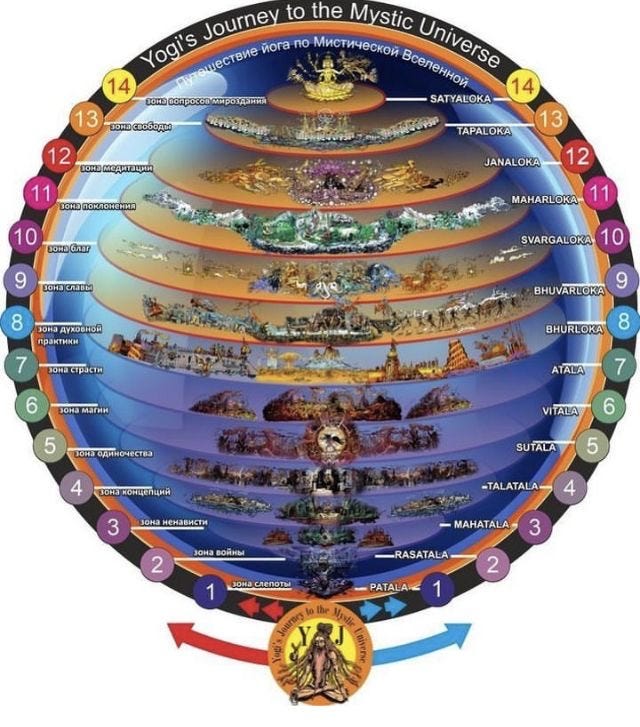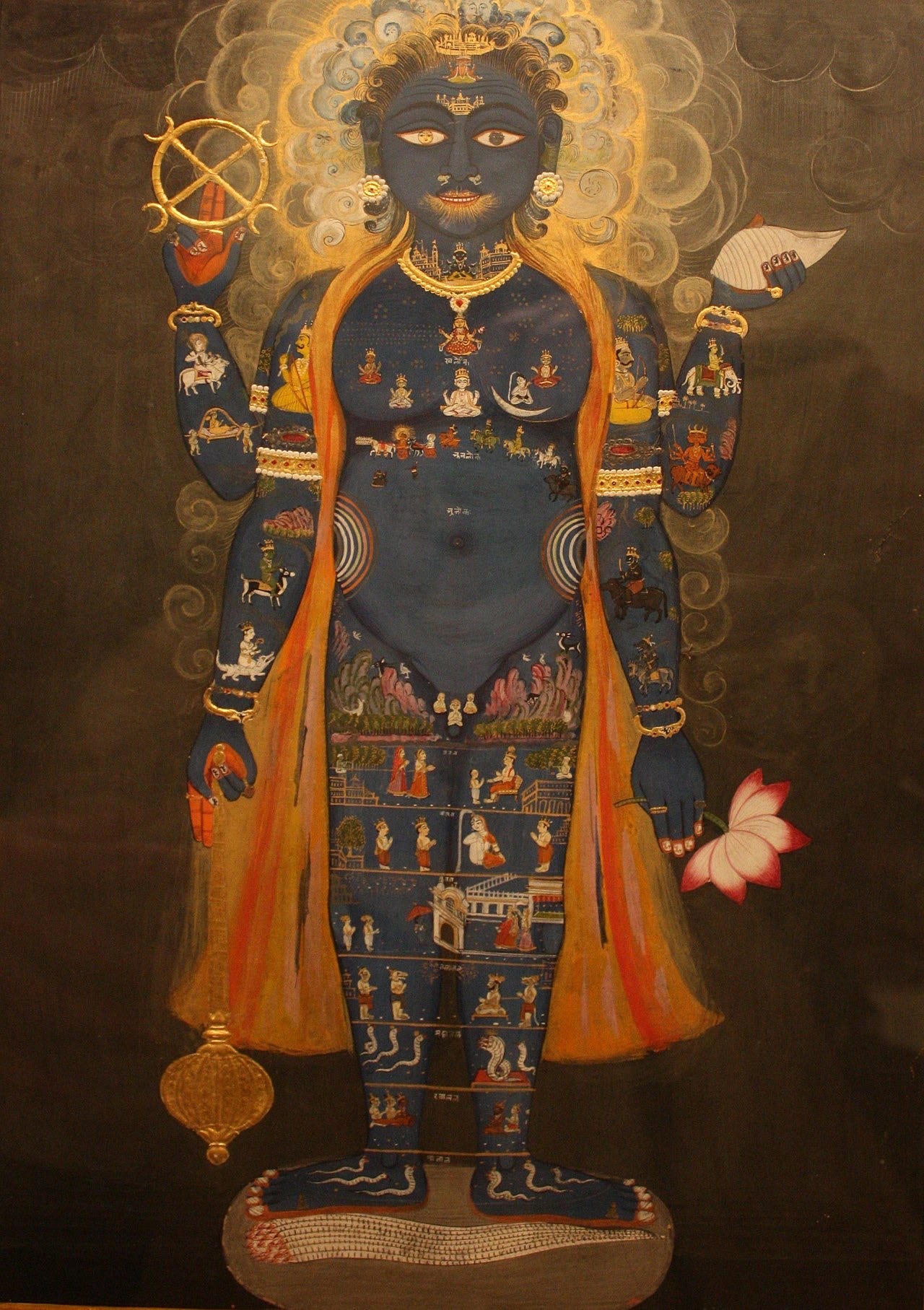The Journey Through Realms: Vedic Lokas and Their Scientific Parallels
**Abstract:**
This paper explores the concept of Lokas (planes of existence) from Vedic literature and examines how this concept aligns or contrasts with modern scientific understanding. By comparing these perspectives, we aim to provide a comprehensive analysis of the Lokas and their significance in both spiritual and scientific contexts.
---
#### **Introduction:**
The concept of Lokas, or planes of existence, is integral to Vedic literature. These realms are described in ancient texts as different layers or dimensions of reality. Modern science, particularly through theories of the multiverse and dimensions, offers intriguing parallels. This paper seeks to compare and analyze these perspectives, providing a holistic understanding of the Lokas.
---
#### **Vedic Perspective on Lokas:**
In Vedic tradition, Lokas are considered realms of existence that correspond to various levels of consciousness and spiritual evolution. There are 14 Lokas, each with unique characteristics and inhabitants. Let's explore each in detail:
1. **Bhurloka:**
- **Overview:** Bhurloka is the earthly realm, where physical existence and material pursuits dominate. It is the plane of human experience and sensory perception.
- **Significance:** It represents the starting point of the soul's journey, where individuals engage in daily life, build relationships, and fulfill their duties (Dharma).
- **Challenges:** Souls in Bhurloka face challenges related to survival, desires, and attachment to material possessions.
- **Growth:** It offers opportunities for learning and growth through experiences, leading to the development of virtues such as compassion, patience, and humility.
- **Spiritual Practices:** Yoga, meditation, and selfless service (Karma Yoga) are emphasized to transcend material attachments and prepare for higher realms.
2. **Bhuvarloka:**
- **Overview:** Bhuvarloka is the realm of spirits and celestial beings, bridging the earthly and divine.
- **Inhabitants:** This plane is inhabited by celestial musicians (Gandharvas), nymphs (Apsaras), and lower deities who have a significant role in Vedic mythology.
- **Role:** Bhuvarloka acts as a transition zone, where souls receive guidance and support from celestial beings to progress on their spiritual journey.
- **Experiences:** It is a realm of artistic and creative expression, where the pursuit of beauty, harmony, and higher knowledge is encouraged.
- **Spiritual Practices:** Devotional practices (Bhakti Yoga) and the cultivation of inner purity are emphasized to maintain a connection with higher realms.
3. **Svarloka:**
- **Overview:** Svarloka is the heaven of gods, ruled by Indra, where joy and pleasure abound.
- **Inhabitants:** It is home to higher deities like Indra, Agni, and Varuna, who govern various aspects of the cosmos.
- **Significance:** This realm represents the fulfillment of righteous actions (Punya) performed in Bhurloka, granting souls access to divine pleasures and happiness.
- **Challenges:** Souls in Svarloka must guard against becoming overly attached to the pleasures and luxuries of this realm, which can hinder further spiritual progress.
- **Spiritual Practices:** Ritual worship (Yajna), chanting of sacred mantras, and the performance of righteous deeds are emphasized to maintain one's place in Svarloka and progress further.
4. **Maharloka:**
- **Overview:** Maharloka is the abode of great sages and enlightened beings.
- **Inhabitants:** This plane is inhabited by rishis (sages) and munis (ascetics) who have attained a high level of spiritual wisdom and insight.
- **Significance:** It is a realm of profound meditation, where the pursuit of ultimate truth (Satya) and self-realization is paramount.
- **Challenges:** Souls in Maharloka must overcome subtle ego and attachments to intellectual knowledge to attain complete liberation (Moksha).
- **Spiritual Practices:** Deep meditation (Dhyana), study of sacred scriptures (Jnana Yoga), and contemplation on the nature of reality are central to spiritual practice in Maharloka.
5. **Janaloka:**
- **Overview:** Janaloka is the realm of saints, representing higher spiritual attainment.
- **Inhabitants:** This plane is inhabited by saints and highly evolved souls who have transcended human limitations and material desires.
- **Significance:** Janaloka is characterized by a deep sense of peace, contentment, and divine presence.
- **Challenges:** Souls must maintain their spiritual focus and avoid falling back into lower desires or egoistic tendencies.
- **Spiritual Practices:** Constant remembrance of the divine (Smriti), devotion to a higher power, and selfless service are emphasized to sustain one's spiritual state.
6. **Tapoloka:**
- **Overview:** Tapoloka is the plane of intense meditation and penance, where souls undergo purification.
- **Inhabitants:** This realm is inhabited by advanced yogis and ascetics who engage in rigorous spiritual practices and austerities (Tapas).
- **Significance:** Tapoloka represents the final stage before achieving liberation, where souls undergo intense purification and transcendental experiences.
- **Challenges:** Souls must endure the challenges of severe discipline and detachment from all material and sensory pleasures.
- **Spiritual Practices:** Practices such as severe austerities, fasting, and deep contemplation on the divine nature are central to Tapoloka.
7. **Satyaloka:**
- **Overview:** Satyaloka is the highest plane, home to Brahma, representing ultimate truth and enlightenment.
- **Inhabitants:** This realm is the abode of Brahma, the creator, and other highly advanced beings who have attained the highest state of consciousness.
- **Significance:** Satyaloka is the realm of pure consciousness, where souls experience complete unity with the divine and eternal truth.
- **Challenges:** There are no challenges in Satyaloka as souls have achieved liberation (Moksha) and exist in a state of perpetual bliss and knowledge.
- **Spiritual Practices:** At this stage, souls have transcended all practices and exist in a state of pure awareness and union with the divine.
8. **Atala, Vitala, Sutala, Talatala, Mahatala, Rasatala, Patala:**
- **Overview:** These are the seven lower worlds, each with distinct qualities and inhabitants, reflecting various aspects of existence.
- **Atala:** The first lower world, ruled by Bala, where beings indulge in hedonistic pleasures and material wealth. It symbolizes excessive indulgence and attachment to physical pleasures.
- **Vitala:** The second lower world, ruled by Hara-Bhava, characterized by intense emotions and passions. It represents the turmoil and conflicts arising from uncontrolled desires and emotions.
- **Sutala:** The third lower world, ruled by the virtuous king Bali, known for its wealth and prosperity but also for material attachments. It reflects the duality of material success and spiritual stagnation.
- **Talatala:** The fourth lower world, ruled by the demon architect Maya, representing illusions and deceptive appearances. It symbolizes the challenges of discerning truth from illusion and the traps of Maya (cosmic illusion).
- **Mahatala:** The fifth lower world, inhabited by serpent-like beings (Nagas), symbolizing hidden knowledge and subconscious fears. It represents the exploration of deep-seated fears and the quest for inner knowledge.
- **Rasatala:** The sixth lower world, ruled by the powerful Asuras, reflecting conflicts and struggles for power and dominance. It symbolizes the battles between light and darkness, good and evil within oneself.
- **Patala:** The seventh and lowest world, ruled by Vasuki, the king of serpents, representing the ultimate depths of ignorance and materialism. It reflects the lowest state of consciousness, dominated by ignorance and base desires.
Each of these lower worlds symbolizes different aspects of human consciousness and the challenges souls must overcome to ascend to higher realms. They serve as a reminder of the consequences of indulgence in lower desires and the importance of spiritual growth.
---
#### **Scientific Perspective on Lokas:**
Modern science delves into the concept of multiple dimensions and the multiverse, providing a framework for understanding the physical and psychological aspects of multiple planes of existence. Here are some key scientific theories and their relevance to the concept of Lokas:
- **Multiverse Theory:** The multiverse theory proposes the existence of multiple universes, each with its unique physical laws. This idea aligns with the Vedic concept of different Lokas, suggesting that there could be parallel realms or dimensions beyond our observable universe.
- **String Theory:** String theory suggests the existence of extra dimensions beyond the familiar three spatial dimensions and time. According to this theory, our universe may be part of a larger multidimensional space, which could explain the existence of different Lokas as described in Vedic texts.
- **Neuroscience and Consciousness:** Neuroscience studies altered states of consciousness and how the brain perceives different realms through meditation, dreams, and other means. Research on practices such as meditation and astral projection shows that the brain can access different states of consciousness, potentially corresponding to the experience of different Lokas.
- **Quantum Mechanics:** Quantum mechanics introduces the concept of superposition and entanglement, where particles can exist in multiple states simultaneously and influence each other instantaneously. These principles could provide a scientific basis for the interconnectedness of different planes of existence and the potential for consciousness to transcend physical reality.
-Comparative Analysis-
**Similarities:**
- Both Vedic and scientific perspectives acknowledge the existence of multiple realms or dimensions.
- These realms are experienced through shifts in consciousness and perception.
- Both perspectives emphasize the interconnectedness of different planes of existence.
**Differences:**
- Vedic Lokas are deeply rooted in spiritual and moral teachings, providing a structured pathway for spiritual evolution.
- Scientific theories focus on empirical evidence, mathematical models, and physical dimensions, seeking to explain the nature of reality through observable phenomena.
**Interdisciplinary Insights:**
By integrating Vedic and scientific perspectives, we gain a richer understanding of the nature of existence. The Vedic framework offers a profound spiritual context for the journey of consciousness, while scientific insights provide tools for exploring and validating these realms. Together, they offer a holistic approach to understanding the multidimensional nature of reality and the potential for human consciousness to transcend physical limitations.
---
#### **Case Studies and Examples:**
- **Historical Examples:** Vedic texts like the Upanishads describe sages accessing different Lokas through meditation and rituals. For example, the Bhagavad Gita narrates Arjuna's journey to higher Lokas guided by Krishna.
- **Modern Examples:** Scientific studies on near-death experiences (NDEs), psychedelic research, and brain imaging reveal similar realms of consciousness. Research on altered states of consciousness, such as those induced by substances like DMT, shows experiences that parallel descriptions of higher Lokas.
- **Personal Accounts:** Anecdotal evidence from both Vedic practitioners and modern scientists experiencing altered states of consciousness. For instance, meditation practitioners report experiencing realms of divine light and profound peace, similar to descriptions of higher Lokas.
---
#### **Conclusion:**
The exploration of Lokas from both Vedic and scientific perspectives reveals profound insights into the nature of existence and the journey of consciousness. Understanding these realms through an interdisciplinary approach provides deeper insights into the nature of reality and consciousness. By blending ancient wisdom with modern scientific understanding, we can navigate the multidimensional landscape of existence with greater awareness and purpose.
---
#### **References:**
- **Vedic Texts:** Upanishads, Rigveda, Bhagavad Gita
- **Scientific Articles:** Research on multiverse theory, string theory, quantum mechanics, and altered states of consciousness.






